|
Creating the Design
There is a bewildering array of color, line, form, and texture of plants and building materials to choose from. It is important to bring these details together in an harmonious manner. Successful coordination creates a garden that is pleasing to the eye; the garden appears natural, balanced, and comfortable. Coordination also helps to camouflage the negative while accentuating the positive features. The details to coordinate are color scheme, line, form, volume, texture, and transition.

Pond Lily
Color Scheme
Create a color scheme by first examining what already exists on your property (house, fence, trees, hedges, hardscape, etc.). Next, consider your color preferences, and organize a color palette that works for you and your property.
Helpful hints:
| • | Choose a shade of green for the hedges. This will be a primary color as hedges are the “bones” of the garden. Does a soft gray-green shade, or a medium forest green, or pale spring green, or a shiny fresh green appeal to you? |
| • | Remember to include complementary, neutral colors if your preference leans toward strong, vibrant color combinations. |
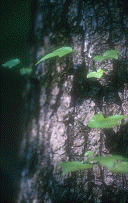
Shadowed tree trunk
with Ivy.
| • | Use a color wheel. It really can be a great help. |
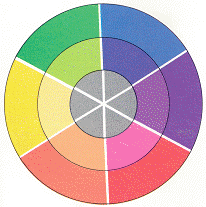
Color Wheel
|
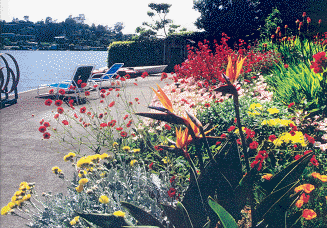
Design: Ali Davidson, Landscape
Color wheel in action
|
Color Wheel
The outer edge of a color wheel shows the primary colors of red, yellow and blue, along with their secondary colors of orange, green, and violet, or purple. The middle circle shows pale tints of the primary and secondary colors as a result of mixing them with white. The inner circle shows shades made by mixing black with the primary and secondary colors.
Warm or Cool
Warm colors (red, orange, and yellow) are considered energizing. If you want to tone down these colors, place them in filtered light or against a dark background. Be spare with these colors, because too much may appear overwhelming and tire the eye.
Cool colors (green, blue and violet) recede and calm. To brighten (highlight) cool colors, combine with white. This is useful for bringing attention to a shaded area. Cool colors disappear in shade and moonlight. White and pastels are washed out in sunlight.
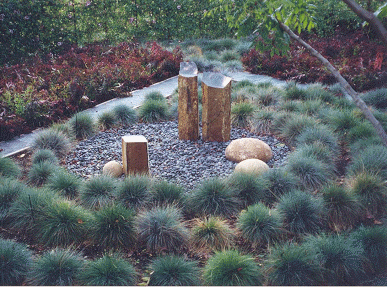
Design: Suzanne Biagi, Sculptural Landscapes
This cool color palette is highlighted with three smooth, pale stones.
Near or Far
Warm colors (and white) make items seem closer and appear larger. Warm colors planted at the foundation line will make your home to appear closer to the street.
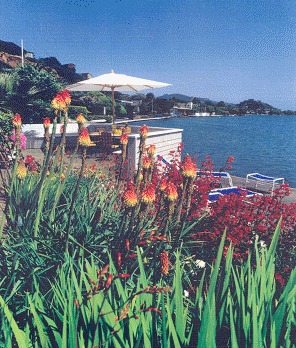
Design: Ali Davidson, Landscape
This warm color palette is toned down by the blue
Pacific Ocean.
Cool colors (and black) make items recede and appear smaller. Cool colors planted at the foundation line will make your home to appear farther from the street.
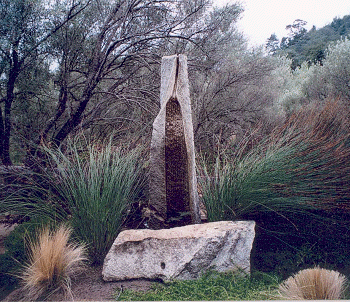
Design: Suzanne Biagi, Sculptural Landscapes
Cool gray colors of the fountain allows it to blend with the
background, suggesting it is further away than it really is.
Color schemes: complimentary, analogous, monochromatic, and triadic.
| a. | A complementary color scheme combines a color with its opposite. A color wheel may be useful for this type of color scheme. For example, green plants next to a red house, fiery fall color with a blue-sky backdrop, or a rustic bench with yellow striped pillows against a purple painted garage wall. |
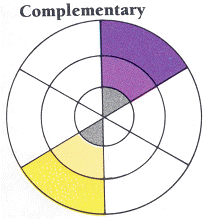
Complementary colors
|
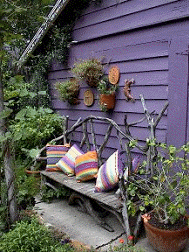
Bold and bright complementary colors
|
| b. | An analogous (or adjacent) color scheme combines adjacent colors on the color wheel. |
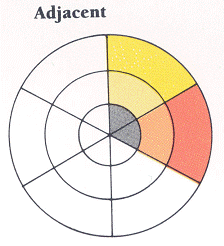
Adjacent color wheel
|
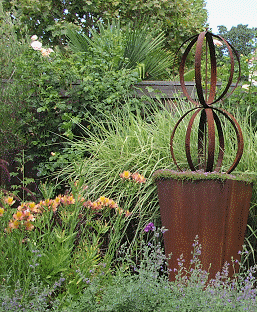
Design: Michelle Derviss, Landscapes Designed
Powerful shades of rust and orange spice this garden.
|
| c. | A monochromatic scheme combines various shades and tints from just one color family; moss and gray green grasses adjacent a gray stone fountain. |
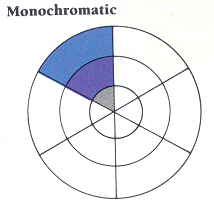
Monochromatic color wheel
|
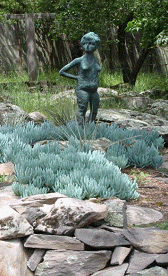
Design: Exteriors Landscape Architecture
Blue hues
|
| d. | A triadic scheme (split-complementary) occurs when three colors equidistant on the color wheel are combined. Some examples of this combination are using red with yellow and blue, or red-orange with yellow-green and blue-violet. |
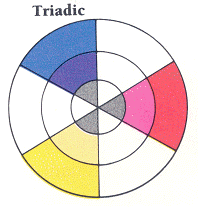
Triadic color wheel
|
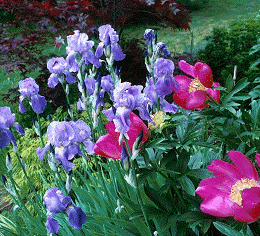
Garden is rich with split-complimentary colors.
|
Color and Rhythm
Repeating the color schemes creates a rhythm that will move the eye through, around, and/or beyond the landscape. For example: alternating rose-pink windowsills and groupings of purple flowers with green shrubbery.
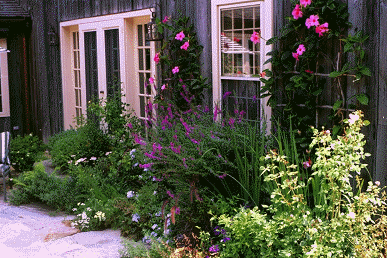
Pink, rose and green colors repeat along the wall and shrub border.
Seasonal Color
Annual plants are considered accent plants. They usually bloom for the one season only and must be replaced each year.
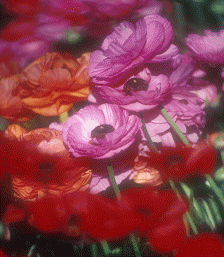
Richly color-saturated Ranunculus
provide the best flowers for cutting in
spring.
Fall color plants (deciduous) are sound investments.
Color change can start in early summer and last through spring.
However, fall color usually means leaf drop, so design with maintenance in mind.
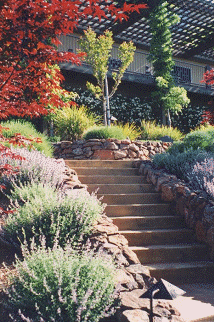
Beautiful fall colors announce steps
|
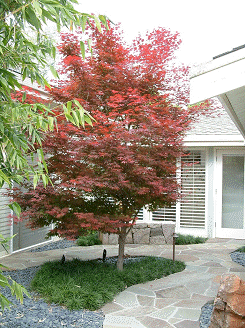
Fall color as a patio focal point.
|
Line
Choosing plants that reflect, or echo, existing lines (natural and architectural) on the property will help unify the garden.
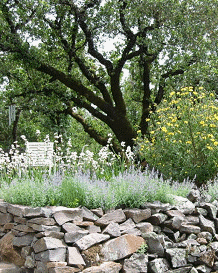
Courtesy Exteriors, Landscape Architecture
Black lines of the Oak tree trunk coordinate
with the creviced stone wall.
|
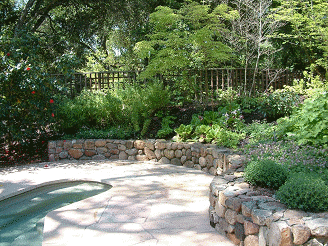
Refined planting follows the elegant curved
line of the stone seat wall.
|
For example: many one level, contemporary homes are styled with horizontal lines, so the garden should mimic the flow of those lines to create harmony.
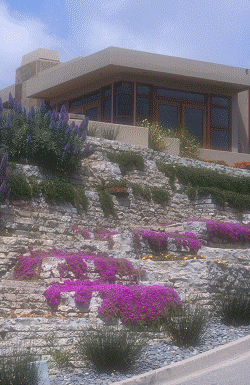
Stone retaining walls are fitted into the
hillside and complete the integration of
structure and site.
|
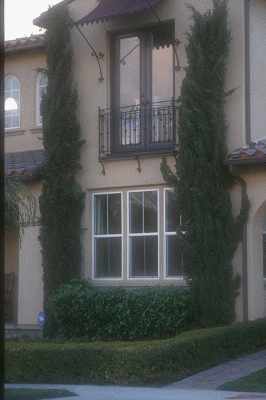
The vertical Cypress trees accentuate the two-
story home’s tall, thin, windows and doors.
|
Besides horizontal and vertical lines, keep in mind the major shapes that occur on your site and try to mimic them with plants.
Strive for an unbroken landscape line with these rules of thumb:
| • | Find out how high and wide the plant will be at maturity before purchasing. Plant height, width, and mass should be in proportion to the home and appropriately sized for the planting location. For example: a 60 foot tree with a 40 foot spread will dwarf a single-story ranch style home. |
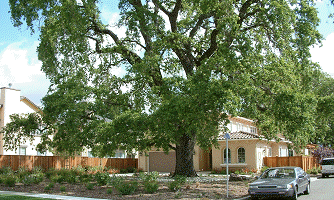
The mature Oak tree is out of scale with the residential site.
| • | Canopy (overhead spreading branches) plants soften building edges and provide shade. |
| • | Create a focal point (terminus) in the garden to provide a visually satisfying resting point. This can be accomplished with either straight or curved lines, or both. An example of a focal point would be a small gazebo in the middle of the garden. To draw the eye to the gazebo, the view of the gazebo is framed by three planes: an overhead plane represented by the sky or overhanging trees; a vertical plane by hedge or wall; and a base plane by paving, lawn, or groundcovers. |
| • | To compliment a stately, symmetrical home, use straight (axial) lines to reinforce the style. To further the formal effect, be sure to create a visually balanced pathway with each side being a mirror image of the other. An example would be two trees, as closely matched as possible, flanking the front door. Or perhaps, identical urns on either side of the entry filled with the same type and color flowers. Also, the eye fools easily, so areas can be made to appear larger, longer, and/or more spacious than they actually are by using straight lines to direct the eye towards a focal point. |
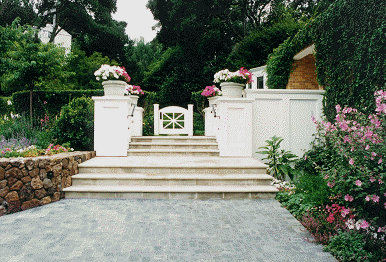
Courtesy Pedersen Associates Landscape Architects
Axial lines created by the paving, wall, and shrub border direct the
eye to the delightful garden gate centered in between. The square
pedestals add balance and symmetry to the garden.
| • | An informal, asymmetrical home may use curved lines to create a flowing, relaxed garden. Curved lines are stronger when curved toward each other than when curved outward. A design has asymmetrical “balance” when opposite shapes on either side of the focal point create equal attraction An example is one tree and a large shrub planted with a bright ground cover. The mass of the shrub would be opposite to the tree’s linear height, but together they would appear balanced. |
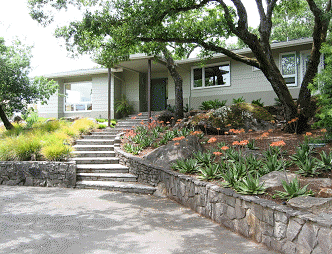
Design: Exteriors, Landscape Architecture
This house is considered asymmetrical because the front
door is not centered. The steps and low garden wall
casually lead to the entry.
| • | Lines should be flowing and graceful and form either a definitive shape or end at a focal point. Avoid the “uncertain,” weaving, in-and-out line. |
| • | Avoid a static line with little or no change. The eye moves easily form one section of the garden to another using lines of continuity. A blank wall, a pathway that ends abruptly, or a formal garden with no focal point will result in a feeling of confusion, or discord. |
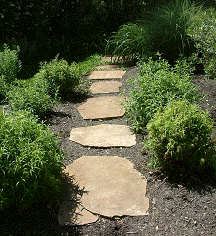
The endpoint of this path is uncertain
because it disappears into the shadow.
Form
Make note of the shape of the dominant forms (structures, trees, shrubs, hardscapes, etc.) on your property. Choose plants that compliment or mimic these forms.
Suggestions on form and design:
| • | Command attention to an entry with an upright plant. |

The two palm trees dramatically announce the entry.
| • | A classic, oval shape can be tranquil, dramatic, or both. |
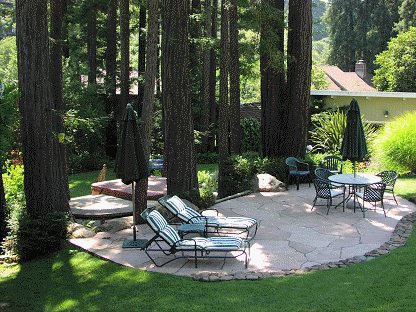
Design: Michelle Derviss, Landscapes Designed,
The oval-shaped patio creates an inviting oasis.
| · | A columnar shape is essential for a formal garden, as it creates living walls and boundaries (garden rooms). |
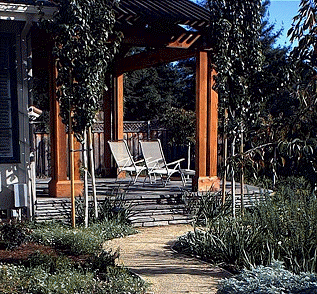
Design: Pedersen Associates Landscape Architects
The columns of the pergola create the illusion of a
Garden ‘room’ with its sense of enclosure.
| • | Fan-shaped leaves on a plant can soften a building edge; however, as you can see, it also may obscure the view as the plant matures. Consult the Plant List or other sources for dimensions of mature plants. |
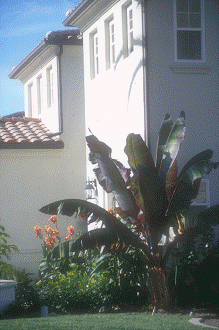
The fanning leaves soften the sharp
edges of the building.
Volume
When designing and drawing a garden plan, keep in mind the volume principle. A two-dimensional drawing may appear more spacious than the three-dimensional real thing.
Rules of thumb for volume:
| • | To avoid overcrowding plants in the garden, be sure to represent the mature size and shape of plants in the drawing plan. |
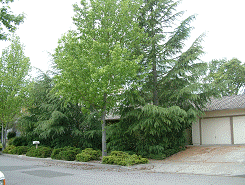
The overcrowded plants obscure the front
of the house.
| • | Hardscapes will make a garden appear large and spacious. Be generous with the dimensions of a concrete path, a brick walk, or a stone patio. Even a small garden will appear spacious if it has paths that are five feet or more in width. Once constructed, the ample paths will provide safety, stability, and a frame for your garden. |
Texture
Texture is the surface quality of an item that can be seen or felt. Surfaces in the landscape include buildings, walks, patios, groundcovers, and plants.
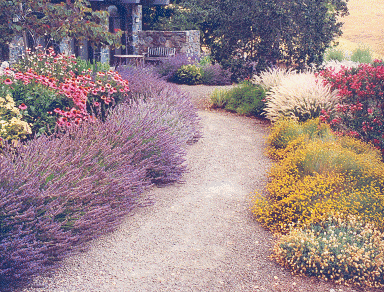
Design: Chris Pedersen, Tending Garden
The fine-textured perennials soften the coarseness of the gravel.
Texture can be coarse, medium, fine, smooth, rough, glossy, or dull. As with the other details, dominant or favorite texture should be used as a guideline in the design in order to unify the garden with the house and rest of the property.
Using texture in your garden:
| • | Paverstone, and some flagstone, have a rustic, coarse texture. They are often used to compliment stucco and/or wood structures such as, walls, fencing, and outdoor furniture |

Rosy pink Satillo tiles planted with fragrant chamomile.
| • | Weathered brick and Arizona flagstone have a medium rough texture that is very complimentary to brick, wood, and plants with small to medium sized, dull leaves. |
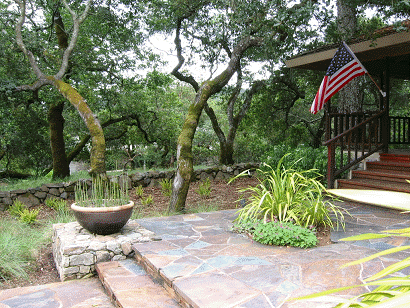
Design: Exteriors Landscape Architecture
Montana flagstone.
| • | Hard-fired brick has a medium to fine texture with a smooth surface. It compliments both Mediterranean and modern structures; galvanized steel cable fencing; wrought iron work; plants with medium-sized, shiny leaves; stucco and hardwood planters; molded ornamental plastic pots; and outdoor molded plastic furniture. |
| • | Tile, such as cut slate and mosaics, can have a texture that is fine, smooth, and glossy. Tiles compliment town-garden entryways and patios; galvanized, wrought iron fencing; furniture; ornamental arches; small-leaved groundcover; smooth foliaged plants; elegant, hard-fired clay pots; and stone containers. |
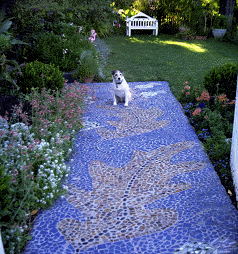
Design: Michelle Derviss, Landscapes Designed
Fanciful mosaic garden path
|
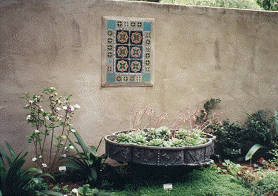
A single polished painted tile floats on concrete
wall.
|
| • | To draw attention to an area use medium size, glossy leaved plants. |
| • | Concrete can be made and poured in any color and texture. |
| • | Use mulch for a soft, dull surfaced pathway. It also allows water to penetrate the soil and helps prevent weed germination. |
| • | Gravel is good for achieving a hard, dull surface. Pea gravel has the finest texture, however, it needs to be replenished often due to gravel seepage (loss of rock due to tamping down and spill over into adjacent beds). Gravel surfaces are attractive, informal, allow water to penetrate the soil, and are low maintenance. It is a good idea to edge gravel areas to help prevent seepage. |
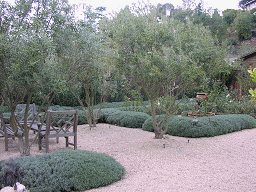
Design: Michelle Derviss, Landscapes Designed
The gravel path lends informality to the
elegant garden.
|
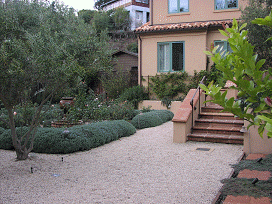
Design: Michelle Derviss, Landscapes Designed
The gravel path also allows for rapid drainage
away from the house.
|
Transition
Transition is the gradual change from one scheme to another. Applying transition, as with the other design concepts, helps to create a surrounding that is gracious and pleasing to the eye. For example, to entice an individual from an enclosed, intimate area to one that is spacious and open, the designer will make the gradual transition by placing plants and forms that graduate in size, height, texture, color, etc. along the exiting pathway. By doing so, one is gently drawn into the open, spacious area.
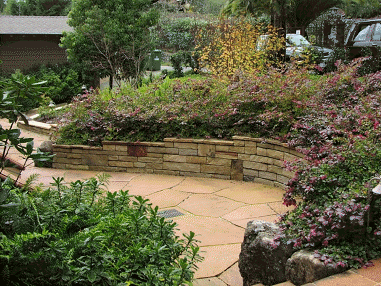
Design: Michelle Derviss, Landscapes Designed
The stepped wall and smooth pathway move
a guest from one garden area to another.
Helpful suggestions on transition:
| • | Transitioning can create a feeling of distance both visually and physically. To generate transition, first choose a focal point that is prominent on the site: a distant hill, a large tree or a shrub, a structure. Place tall plants near an area where someone would naturally stand. Now position shorter and shorter plants along the pathway that leads to the focal point Transitioning darker colors to paler colors, or coarse textures to fine textures, can also extend the view outwards. |
| • | To shorten the distance, use the opposite approach of the above. |
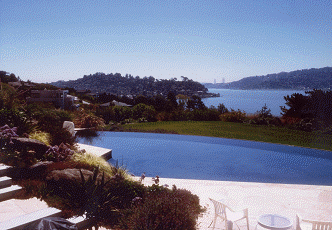
Design: Pedersen Associates, Landscape Architecture
The shallow width of the classic oval swimming pool
shortens the viewing distance from the patio to the
ocean and hills.
Before you start laying out your garden on paper, there are other details (building codes, utilities, soil, weather/climate, etc.) that need to be addressed in planning your garden.
|
